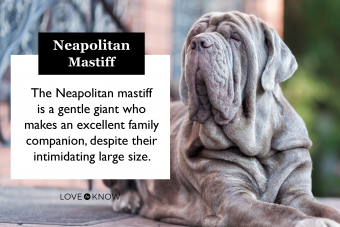
Neapolitan Mastiffs immediately leave an impression, with their impressive size, droopy skin, and stoic looks. Although they can be imposing, Neapolitans are equally friendly and even-tempered. Also known as neos and mastinos, these mastiffs are large, loyal companions who will serve as protectors and valued members of the family.
Origin and History
The Neapolitan Mastiff's lineage dates back to 3000 B.C., when their ancestors were working as guard dogs and working dogs. The dog that would become the Neapolitan Mastiff was created in southern Italy, near Naples. The goal of the Neapolitan breeders was to create a huge dog with heavy, loose skin who could protect them in the event of an attack. They also wanted a dog that would be devoted to their family members.
In 1949, the Federation Cynologique Internationale (FCI), an international dog registry, recognized the breed. Jane Pampalone introduced the first Neapolitan Mastiff to the United States in 1973. The breed was recognized by the American Kennel Club (AKC) in 2004.
The Neapolitan Mastiff Club of America (NMCA) was founded in 1973 and maintains a register of pedigrees, ancestry, and ownership for the majority of Neapolitan Mastiffs in the United States. The club's other purpose is to educate the public about the breed.
Breed Characteristics
Neapolitan Mastiffs are not aware of their size and will happily jump on the couch to offer you some affection.

Appearance
The Neapolitan Mastiff's head is massive and square, with a distinct stop between the eyes. A muzzle that is half the length of the head is ideal. The medium-sized brown to dark hazel eyes are positioned wide apart and set deep in the head. The hue of the nose is often dark in color. The dark-colored, tiny ears are V-shaped and in proportion to the skull.
Heavy, velvety wrinkles and folds run from the outside margin of the eyelids to the dewlap (the loose, pendulous skin beneath the throat and neck) and from under the lower lids to the outer edges of the lips on the Neapolitan Mastiff's face.
Their coat comes in solid gray, black, mahogany, and tawny. Some brindling is allowed, but it must be tan, known as reverse brindling.
Males can weigh as much as 200 pounds, though the average male comes in closer to 150 pounds. Females typically weigh around 110 pounds. Height in males averages 30 inches at the shoulder, whereas females are a little shorter at 27 inches tall.
Temperament
Don't let their appearance deceive you; they will be your 150-pound oversized lapdog. Although they may intimidate strangers with their overwhelming bodies, they're not known to be aggressive. They will defend you if necessary, but they prefer to stay peaceful.

Training
The Neapolitan Mastiff is a stubborn dog who requires a patient and consistent owner. Start early with your training, be firm and consistent, and utilize positive reinforcement strategies, including praise and food rewards in your training. Housetraining shouldn't be difficult if you make it fun for your dog and give them a regular bathroom schedule and plenty of opportunities to go outdoors.
Crate training is an excellent method for housebreaking your puppy and preventing them from chewing on items they shouldn't.
Neapolitan Mastiffs require early socialization, including exposure to a variety of people, sights, sounds, and experiences. Make sure these are structured and positive experiences, as you want to ensure your neo comes away feeling confident and happy, as much as possible. Your Neapolitan Mastiff puppy will grow up to be a well-rounded adult dog if they are socialized.
Exercise Requirements
Neapolitan Mastiffs have a tendency to be sedentary, but frequent exercise will keep them happy and healthy. This mastiff, like all dogs, should be taken for daily walks to help release mental and physical energy.

Health
Although Neapolitan Mastiffs are typically healthy, they are susceptible to some health issues:
- Canine hip dysplasia: This is a painful joint and skeletal disorder that tends to affect larger breed dogs.
- Cardiomyopathy: A condition that occurs when the heart muscle becomes very thin and is unable to contract normally.
- Cherry eye: This condition results when a gland in the eye begins bulging.
- Cleft palate: An opening between the mouth and nose, this condition is characterized by a slit that runs bilaterally or unilaterally and can be small or substantial in size.
- Fold dermatitis: A skin infection caused by moisture trapped in the folds of the skin.
Lifespan
The average lifespan of a Neapolitan Mastiff is 10 to 12 years, although some members of the breed may live longer.
Grooming
The short-haired coat is smooth and easy to groom. For a dazzling finish, brush with a firm bristle brush and wipe with a piece of toweling or chamois. Bathe or use dry shampoo as needed. This breed doesn't shed much, so you don't have to worry about fur showing up all over the house.
Fun Facts About the Breed
The Neapolitan Mastiff is a well-known breed, but there are some interesting tidbits you may want to know:
- The Neapolitan Mastiff is an ancient dog breed, and their ancestors have been around since Julius Caesar's reign in the Roman Empire.
- They're well-known for their slobbering, drooling, wheezing, grunting, snorting, and flatulence.
- Although they're good guard dogs, they aren't known to bark excessively.
- They have been involved in police and military work.
Purchasing or Adopting a Neapolitan Mastiff
If you're looking for a Neapolitan Mastiff puppy, a good place to start is with the Neapolitan Mastiff Club of America, the offical breed club through the AKC. It offers a breeder directory as well as helpful tips on how to find responsible breeders with quality dogs. The AKC Marketplace also has a breeder search. Expect to pay around $2,000 to $3,000, although higher-end show dogs from champion lines can cost as much as $5,000.

Rescue Organizations
If you're looking to rescue a member of the breed, and aren't particular on age or purebred status, you can begin your search on PetFinder and Save-a-Rescue. If you're looking for purebreds or specific mixes, you might prefer to visit breed-specific rescue organizations:
- Manstino Rescue: A nationwide rescue organization dedicated to rescuing and educating the public about the Neapolitan Mastiff.
- Mastiff to Mutts Rescue: A nonprofit organization rescuing Neapolitan Mastiffs and other large breeds.
- Great Lakes Mastiff Rescue: A nonprofit rescue organization located in Chicago.
Is this the Breed for You?
If you aren't looking for a large dog to sit on your furniture and lay about, this may not be the breed for you. If you're searching for a loving gentle giant who will cuddle and protect you, do your research and find a puppy that's right for you. They will make a loving family companion and great guard dog.







